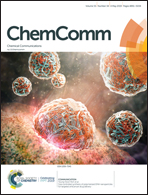d8⋯d10 RhI⋯AuI interactions in Rh 2,6-xylylisocyanide complexes with [Au(CN)2]−: bond analysis and crystal effects†
Abstract
The well-known [RhL4]n(anion)n structures, with RhI⋯RhI d8⋯d8 interactions, are replaced by others with RhI⋯AuI d8⋯d10 interactions such as [{RhL4}{Au(CN)2}] (L = 2,6-xylylisocyanide) or [{RhL4}{Au(CN)2}{RhL4}{Au2(CN)3}·4(CHCl3)]∞ when the anion is [Au(CN)2]−. Orbital (Rh⋯Au), coulombic, and inter-unit π–π aryl stacking interactions stabilize these crystal structures.
![Graphical abstract: d8⋯d10 RhI⋯AuI interactions in Rh 2,6-xylylisocyanide complexes with [Au(CN)2]−: bond analysis and crystal effects](/en/Image/Get?imageInfo.ImageType=GA&imageInfo.ImageIdentifier.ManuscriptID=C9CC01377F&imageInfo.ImageIdentifier.Year=2019)


 Please wait while we load your content...
Please wait while we load your content...